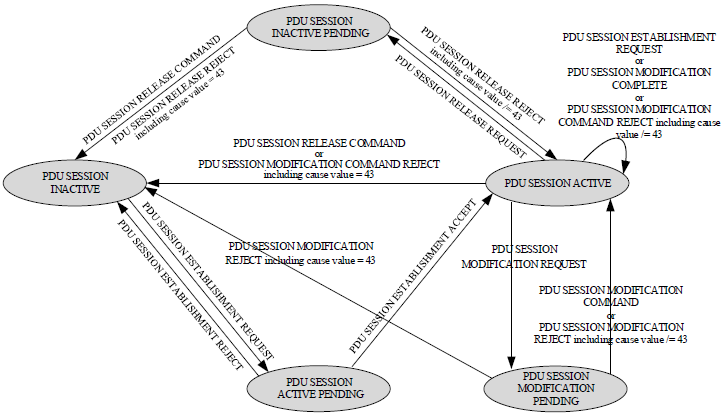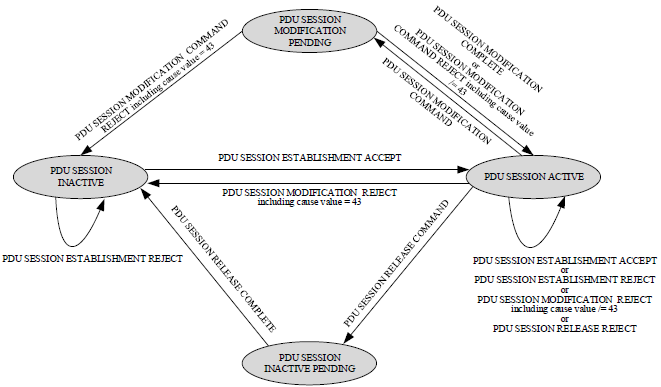|
|
||
|
Very simply put, 5GSM is a functional layer within the 5G core network that is dedicated to managing all procedures related to Packet Data Network connectivity. It acts as the control framework for establishing, modifying, and releasing PDU sessions, which are the logical data connections that carry a user’s internet and application traffic over the 5G system. According to 3GPP TS 24.501, Section 6 on Elementary Procedures for 5GS Session Management, the primary role of the 5GSM sublayer is to coordinate PDU session handling between the UE and the Session Management Function (SMF), with signaling exchanged via the Access and Mobility Management Function (AMF). In practice, this means 5GSM governs the lifecycle of a PDU session from its creation—when a user launches an application or service requiring data—through updates that might change quality of service or routing, to its eventual termination when it is no longer needed. By ensuring these procedures are consistently and securely executed, 5GSM provides the foundational control needed for seamless data service delivery in a 5G network.
Overall Functions of 5GSM
Overall description of 5GSM is well described in 24.501 - 6.1.1 as follows :
The 5GSM comprises procedures for:
Each PDU session represents a PDU session established between the UE and an SMF. PDU sessions can remain established even if the radio and network resources constituting the corresponding PDU session between the UE and the SMF are temporarily released. 5GSM procedures can be performed only if a 5GMM context has been established between the UE and the AMF, and the secure exchange of NAS messages has been initiated by the AMF by use of the 5GMM procedures described in 5GMM Section. Once the UE is successfully registered to a PLMN, a PDU session can be established. If no 5GMM context has been established, the 5GMM sublayer has to initiate the establishment of a 5GMM context by use of the 5GMM procedures as described in 5GMM Section. The UE can request the network to modify or release PDU sessions. The network can fulfil such a request from the UE by modifying a PDU session or releasing a PDU session using network-requested procedures
5GSM Statemachine
5GSM is very complicated process described in about 100 pages for overall functionaligy in 24.501-6 and around 40 pages for NAS signaling message handled by 5GSM in 24.501-8.3. You would easily get lost if you directly jumping into reading the details. My recommendation is to try to get familiar with the following statemachine to the point where you can draw the statemachine by hands and then read the specification as-you-need basis.
PDU Session Handling in UE
Following state machine diagram illustrates the lifecycle of a PDU session in the 5G System happending in UE. It captures the various phases a PDU session undergoes, from inactivity to potential modifications and active data transmission. The transitions represent events or commands that cause the session to change its state, showing the dynamic nature of session management in 5G networks.
< 24.501-Figure 6.1.3.2.1.1: The 5GSM sublayer states for PDU session handling in the UE (overview) >
PDU SESSION INACTIVE : This is the state where the PDU session is not active, meaning there's no ongoing data transmission for this session. Followings are transition to other states:
PDU SESSION ACTIVE PENDING : This state indicates that the PDU session is in the process of becoming active. Followings are transition to other states:
PDU SESSION ACTIVE : The PDU session is active and data transmission is possible in this state. Followings are transition to other states:
PDU SESSION INACTIVE PENDING : This state indicates that the PDU session is in the process of transitioning to an inactive status. Followings are transition to other states:
PDU SESSION MODIFICATION PENDING : This state signifies that modifications to the PDU session parameters or settings are being processed. Followings are transition to other states:
PDU Session Handling in Network
The Following state machine diagram shows the lifecycle of a PDU session in the 5G System happening in the network side. It encapsulates the various states and transitions a PDU session undergoes, including initiation, modification, and termination. Through this structure, the network manages and adapts to the dynamic requirements and conditions of data sessions, ensuring efficient communication and resource allocation in a 5G environment.
< 24.501-Figure 6.1.3.3.1.1: The 5GSM sublayer states for PDU session handling in the network (overview) >
PDU SESSION INACTIVE: This is a state where the PDU session is not currently active, indicating there's no ongoing data transmission for this session. Followings are transition to other states:
PDU SESSION ACTIVE: In this state, the PDU session is active, and data transmission is feasible. Followings are transition to other states:
PDU SESSION MODIFICATION PENDING: This state signifies that there's an ongoing process to alter the PDU session's parameters or characteristics. Followings are transition to other states:
PDU SESSION INACTIVE PENDING: This state represents that the PDU session is in transition towards an inactive status. Followings are transition to other states:
NAS Signaling Procedures Handled by 5GSM
Followings are the list of NAS signaling (OTA procedure) handled by 5GSM. I think these message (process) list would give more concrete idea to most of the readers since analyzing OTA message would be pretty common practice. I will create separate notes for each of these process and put the link as I complete the note... but not sure how long it will take to complete all of them, but I will try to complete at least 5G specific process as early as possible. For most of other procedures, I think you can apply your LTE knowledge. Each of NAS messages involved in each of these procedures are described in 24.501-8.3. As you see, 5GSM is just all about PDU session.
YouTube
|
||

